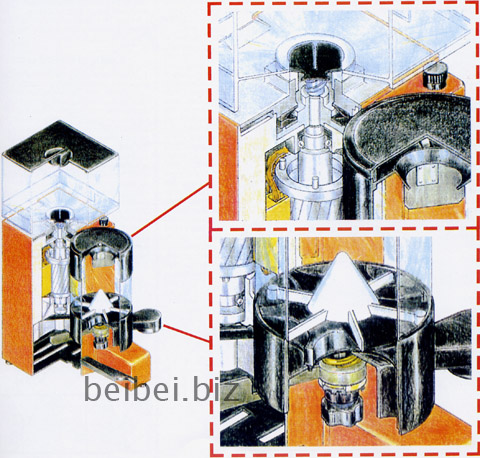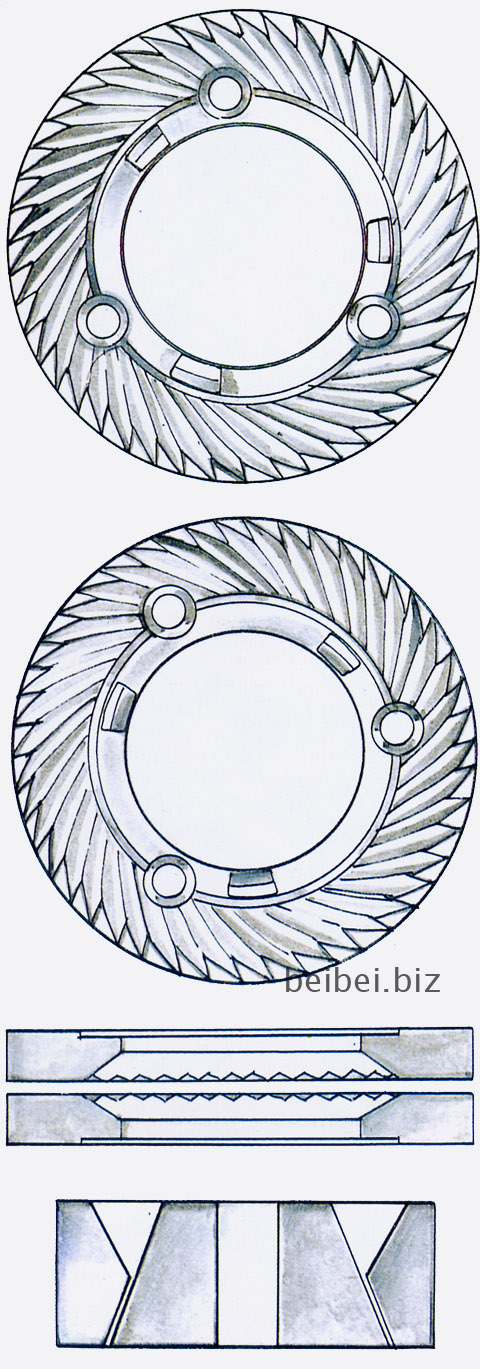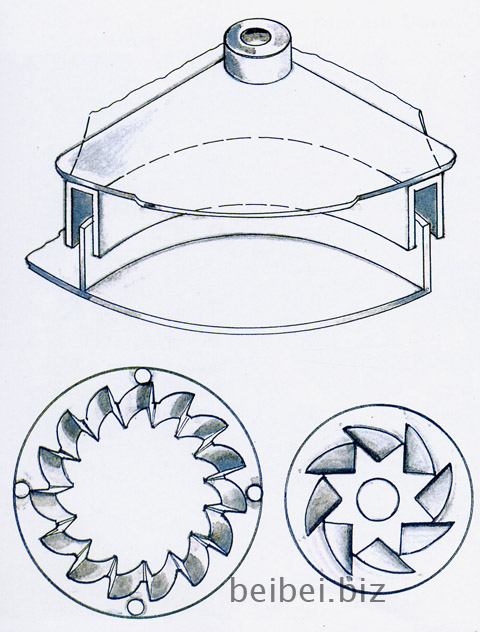咖啡磨/分量器
咖啡磨的作用是把咖啡豆子准备好(磨成粉末),以便于在意式咖啡的制作中可以释放出咖啡所具有的香味和香气。这是一个极端重要的过程,黄金法则是,在咖啡粉要被使用前才进行研磨。粉末的细密程度以及均匀性是后续过程成功的基础。在许多的餐馆里,甚至是在某些意式咖啡馆里,一只好咖啡磨对于优良的意式咖啡的重要性经常是被低估的。我们将专注于在营业用的咖啡磨/分量器机器,而不会涉及市场上存在的其它版本(比如旋转页片式的磨,或是手摇磨)。咖啡磨/分量器的主要组成部分有:盛料器(Bell):在机器的顶部,盛整个儿的咖啡豆用的。磨:两片金属片状的牙齿,其间的距离可以调节。分量器:盛磨好的咖啡粉,并量出一杯意式咖啡完好所需的份量。
扁平状磨片 (Flat Grinders)
扁平状磨片包含有一对带牙齿的钢材做的圆盘。一个圆盘被安装在驱动轴的顶部,由三个螺钉固定;另外一个圆盘被放在一个螺杆上面的螺帽上,以便调节两个圆盘间的距离。经由减少或增加两个圆盘间的距离,咖啡可以被磨得更细点儿或是更粗点儿。
咖啡研磨的粗细可以经由减少或增加两个圆盘间的距离来相应调整。这两个圆盘会持续磨损,因此每磨400-600kg咖啡就要换掉,这个数字由所用的咖啡的品种而有所变化(比如罗布斯塔就会更硬些),也会由圆盘采用的钢的种类,以及圆盘的直径而有所变化。换这些圆盘是非常容易的。尽管如此,(在更换时)圆盘的座子一定要仔细清洁,以确保这些圆盘一直保持完美的平行,以免造成驱动轴变偏。咖啡豆从盛料器中落下,落到磨的中央,磨片以900到1700 rpm (每分钟900到1700转)的速度转动,造成引力把磨好的咖啡粉推出,进入到分量器中。在那些按份量卖咖啡粉的场合不推荐用这种磨,因为长时间连续使用会造成磨片过热,而过热的磨片会给咖啡的风味带来负面的影响。
圆锥状磨片 (Conical Grinders)
与扁平状磨片两片相同的磨片相对应地,锥型磨的两片磨完全不同。固定在驱动轴上的部分是被切去顶端的圆锥形,它的直径比固定在螺杆上的那个磨片小很多。内部的部件,一个反转的切去顶端的圆锥,包含固定在驱动轴上的部件。(注:这段用词好恶… 我另发之前译的一篇关于咖啡磨的文章上来,配图的。看那篇就明白了)
这种型号通常被用来磨较大量的咖啡。牙齿的表面很大,所以会比较不易磨损(可以磨900到1300kg的咖啡)。机器在更短的时间内产生出更多的咖啡,而过热仅发生在磨了实在太大量的咖啡的时候。咖啡豆从盛料器内落到咖啡磨部件的顶部,经由重力的作用从磨的底部出来,不需要吸引力,也就不需要磨转动太高的速度(实际上380 – 480 rpm的转速就足够了)。
分量器 (The Measuring Device)
分量器是一个圆柱状的容器,在底部有一个六角星,六角星的每个扇区盛有一杯咖啡所需要的足量咖啡粉。每杯咖啡的粉量可以由升起或降低六角星上面的圆盘来调节。
很细的咖啡粉会粘在六角星的壁上,这样一来不同扇区的咖啡粉量就会有所不同,它们每次拨出来的咖啡粉的量也就不会是固定的量。
贮藏 (Storage)
烘焙好的咖啡豆必需贮存在密封罐中,咖啡豆会吸湿(记住,在烘焙中豆子失水可达22%),因此烘好的咖啡豆会吸收水气和其它气味。
存贮咖啡的地方的温度永远不要低于10摄氏度,因为这样低的温度会使油和脂肪凝固,毁掉意式咖啡。即使以上条件只有一条发生,产品(意式咖啡)就会变差,而且会影响咖啡的感观质量(意式咖啡感观上本应该是芬芳、醇厚,呈暗榛子仁色)。






《“[翻译]咖啡磨/分量器”》 有 1 条评论
The Grinder/Meter
The purpose of the coffee grinder is to prepare the coffee beans so that release all their fine fragrance and aroma when the espresso is being made.It’s a vitally important process and the golden rule is to grind the coffee iust when it。s going to be used.The fineness of the powder,and its homogeneity are essential to the success ot the following procedures.The importance of a good coffee grinder made for the amount of coffee to grind for the espressos to be made is often underestimated ln manY restaurants and even in some espresso bars.We will concentrate on protessional coffee grinder/measuring machines tnat are used in most public establishments fwithout going into the general aspects ot many existing versions on the market,from the rotating blade to manual types).The main components of the grinder/measuring machines:Bell:on top of machine it contains the whole coffee beans.Grinder:two metal disks teeth at an adjustable distance from each other.Measuring device:contains the ground coffee and measures out the exact amount needed to Prepare one cup ot espresso.
Flat Grinders
The flat grinders consist of a pair of toothed steel disks.One disk is generally mounted on the top ot the driving shaft and fastened with three screws;the other one is put on a threaded ring nut so that the distance between the two can be adjusted. Coffee can be ground finer or coarser by decreasing or increasing the distance between the two can be adjusted.
Coffee can be ground finer or coarser by decreasing or increasing the distance between the two disks,respectively.The disks are subject to constant wear and therefore have to be replaced every 400/600 kg of coffee;the amount varies according to the type of coffee used(the Robusta varieties are harder and woodier).the type of steel and the diameter Of the disks.It’s very easy to replace the disks.However,their seats have to be cleaned carefully to make sure that the disks are always perfectly parallel.to prevent the driving shaft from getting out of alignment.The coffee beans come down from the bell and fall to the middle of the grinders which,rotating at speeds from 900 to 1700 rpm create a centrifugal force that pushes the ground coffee out and into the measuring device.This type of grinder is not recommended for coffee sold by weight;extended use overheats the grinders and this.in turn.will have a negative impact on the coffee’s flavor.
Conical Grinders
As opposed to the flat and identical grinders.the conical devices differ completely.The part fastened to the driving shaft is truncated cone and its diameter is much smaller than that of the part fastened to the ring nut and which regulated grinding.The internal part,a reversed truncated cone,holds the part fastened to the driving shaft.
This model is generally used to grind large amounts of coffee;the larger toothed surface is 1ess susceptible to wear (and can grind from 900 to 1300 kg of coffee).The machine yields more coffee in less time and overheating only occurs when grinding really 1arge amounts.The coffee beans from the bell fall onto the top part and come out the bottom because of gravity without the need for centrifugal forces (in fact a speed of 380/480 rpm is sufficient).
The Measuring Device
The measuring device iS a cylindrical container with a six—pointed star at the base,each sector of the star holds enough coffee for one cup of express.The amount of coffee per cup can be adjusted by raising or lowering the plate located above the start.
The very fine or impalpable part of the coffee may stick to the walls of the star and change the volume available in the various sectors SO that they do not deliver constant amounts of cottee.
Storage
Roasted coffee beans must be stored in hermetically sealed cans is hygroscopic(remember that during roasting it loses up to 22% of its moisture content)and therefore it absorbs moisture and odours.
The temperature in the storage area should never be less than 10。C because it would freeze the naturaI oils and fats and ruin the quality of the espresso.If even only one of the above conditions should occur,the product would deteriorate and lose the organoleptic qualities that make it possible to serve a fragrant,thick and dark hazelnut coloured coffee.